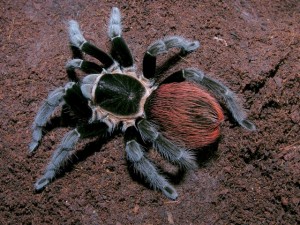Mexican Red Rump (Brachypelma vagans)
Brachypelma, New World 13 Comments »The Mexican Red Rump (also known as the B.vagans) is a tarantula originally from Mexico but can be found in Guatemala and El Salvador. These tarantulas are very striking due to their jet black color and their dark red urticating hairs on their abdomen. Females tend to age as old as 15 years while a male age around 5 to 6 years. Most Mexican Red Rumps end up grow fast and a fully mature tarantula will end up being about 6 inches in length.
Habitat:
The Mexican Red Rump love a dry environment. For a full size Mexican Red Rump the most you will need would be a 10 gallon enclosure. Make sure it has a temperature of about 75 to 85 degrees with about 65% humidity. We would recommend you add a substrate such as eco-earth and simply making a corner of the enclosure damp. This species is also known for burrowing so be sure to setting your substrate with a depth of 3 to 4o inches. Make sure to also provide a water dish and bark in the enclosure in the event your tarantula gets thirsty or needs a place to hide.
Feeding:
Feeding should not be a problem at all. In the wild these tarantulas are known for feeding on insects and small rodents or lizards. In captivity however, they will survive just fine on a steady diet of large crickets and cockroaches. You can not overfeed these animals and the more they want to eat the more you can feed them.
Attitude:
These animals are quite docile and being New World tarantulas are very slow. However they do suffer from mood swings from time to time and may become skittish. They are normally very easy to handle but be sure to check your tarantula out to see if its in the mood to be touched. As a defense mechanism they do flick off their urticating hairs and as last resort bite. This is very rare and should not be something of extreme concern.
Your Mexican Red Rump will spend most of its time just sitting in one spot and not moving much. They are very easy to handle and are recommended for beginner/intermediate tarantula hobbyist. Following simple steps you can ensure your tarantula lives a long and healthy life and will be easy to handle.



